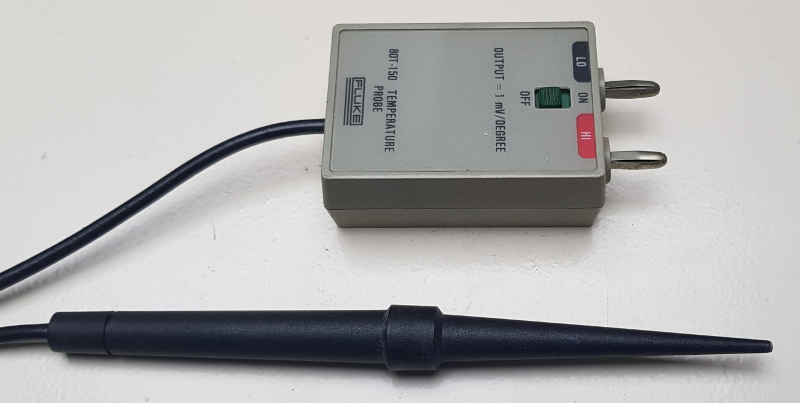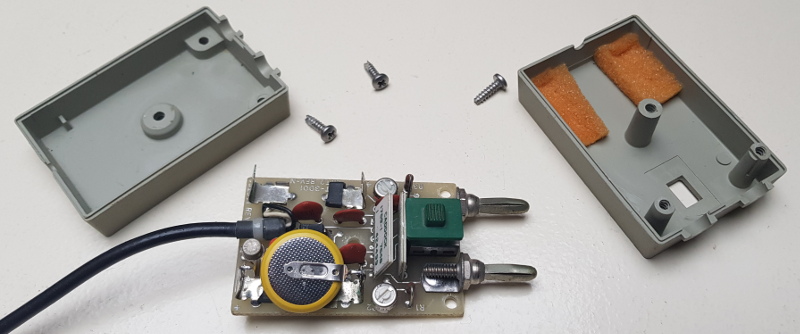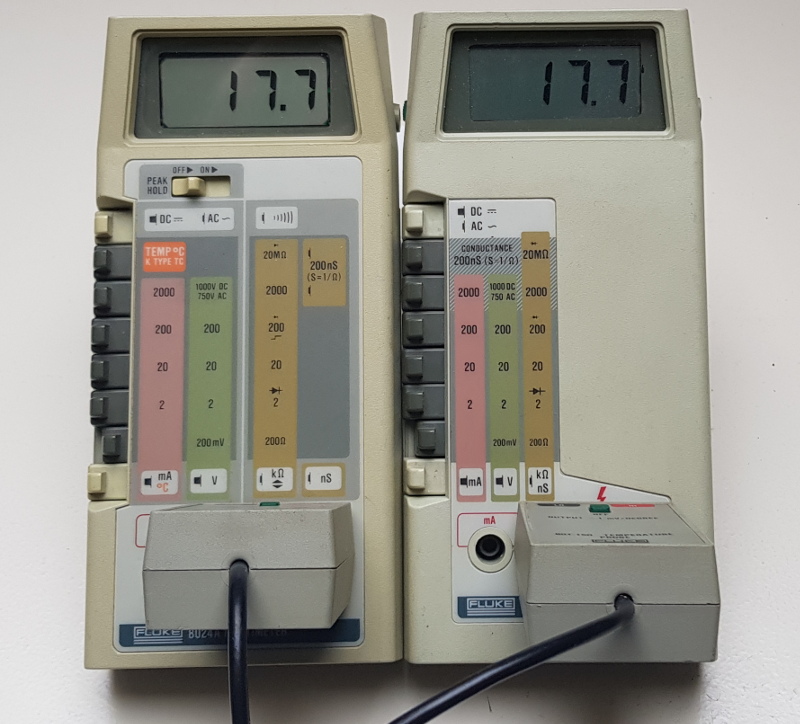Fluke 80T-150 Revival
This is not so much as a project.
It’s more a memo to myself.
I own two Fluke 80T-150 temperature to voltage adapters.
They use a silicon PN junction as temperature sensor and convert the forward voltage, which is inversely proportional to its temperature, into a voltage between -50 mV and 150 mV, which in turn can be measured by a normal digital Voltmeter.
Every milli Volt then counts for one degree Celsius.
It can also be configured to measure Fahrenheit, in case you live in a part of the world that prefers that scale.

Batteries
The thing with these two devices is that they require two N-type batteries each, which are not quite common. So I don’t have any laying around, just in case I’m in need of a thermometer.
And I have noticed that both devices suffer from some traces of battery leakage, because at some point in the past I had left the batteries in there and had forgotten about them.
Buying some N-type batteries, just in case I ever need to measure temperatures before they reach the end of their shelf life sounds a bit ridiculous to me.
Let’s see if I can run them from a CR2032 battery for a reasonable amount of time.
These batteries cost next to nothing, have an excellent shelf life expectancy and zero chance of leaking as a bonus.
I would have been over the moon if it would run for at least a full day. After all I don’t measure temperatures that often. And when I do, I’m not going to hold the probe in my hand for more than a few minutes at a time. A day worth of juice would be more than sufficient. I was much surprised by the operation time I could get out of one single coin cell. After about a day the voltage on the cell dropped to about 2.85 V. And it stayed at that value for about a week. It took the battery yet another week to drop to 2.75 V, which is still more than enough to power the adapter. Only then I saw the voltage decaying within the next half week to a value below 2.5V.

Anyway, now I know a single coin cell will probably last a lifetime, if I don’t forget to switch the power off when the thermometers are not in use.
The coin cells I use have solder pins welded to them.
Bending these pins outwards made them just wide enough to solder the coin cell between the top of the two terminals of one of the N-type battery holders.
The other cell’s holder had to be shorted to complete the circuit again.
After careful inspection of the adapters I found that the black sensor wire from one of them had almost completely rotted away.
I have no idea why that has happened.
The damage caused by the leaking batteries has never been that extreem, at least not that I can remember.
I had to cut a few centimeters from the probe wire to find the cores to be clean enough again.
This also revealed that the pads on the PCB are very fragile too.
Luckily I was able to put everything back together again.
Calibration
All that was left to be done was to calibrate the thermometers.
One of them was 1 degree off from the room temperature compared to a DS18B20, which I used as a reference.
The other one was 2 degrees off.
I was lucky to be able to find a copy of the service manual for the 80T-150 online.
It appears that the device in that manual was equipped with a Lithium battery too.
Not a coin cell though.
The rest of the circuit was the same as mine, as far as I can tell.
The relationship between the temperature and the forward voltage of a PN junction of a silicon diode is quite linear between -50 °C and +150 °C. However the offset and slope may differ quite considerably between different probes. The offset is calibrated at a low temperature, while the slope can be calibrated at a high temperature.
Officially the temperatures must be calibrated using melting ice from demineralized water as a low point, and boiling demineralized water as a high point.
However any contamination in water might shift the freezing and boiling point of water.
And so does the air pressure.
I’ve decided not to bother too much.
Therefore I’ve just used normal tap water.
And I’ve used the aforementioned DS18B20 as a reference thermometer.
I’m quite satisfied when my Fluke’s measure the same temperature as the DS18B20 in both extremes.
I submerged the probes of both adapters in melting ice together with the DS18B20 reference thermometer.
And once the temperatures were stable I tweaked R2 to make them both read the same value as the reference thermometer.
Be careful to hold your tongue at the right angle while gently stroking your long white beard while you do so.
It will make the result that much more accurate.
After that I submerged the probes and the reference thermometer into next to boiling water, and tweaked R4 this time.
After that I submerged everything into a glass of water at room temperature to verify the calibration.
They Are Alive Again

So now I have two nice temperature to voltage converters which can be used to measure any temperature between -50 °C and +150 °C with a normal multimeter.
Almost 40 years old, and still going strong!
I can even use my MooshiMeter for that!
Old meets young.
Navigation
Sponsors
Please consider clicking on the Support Me button to show your appreciation.
![]()
My way of keeping this site alive.
